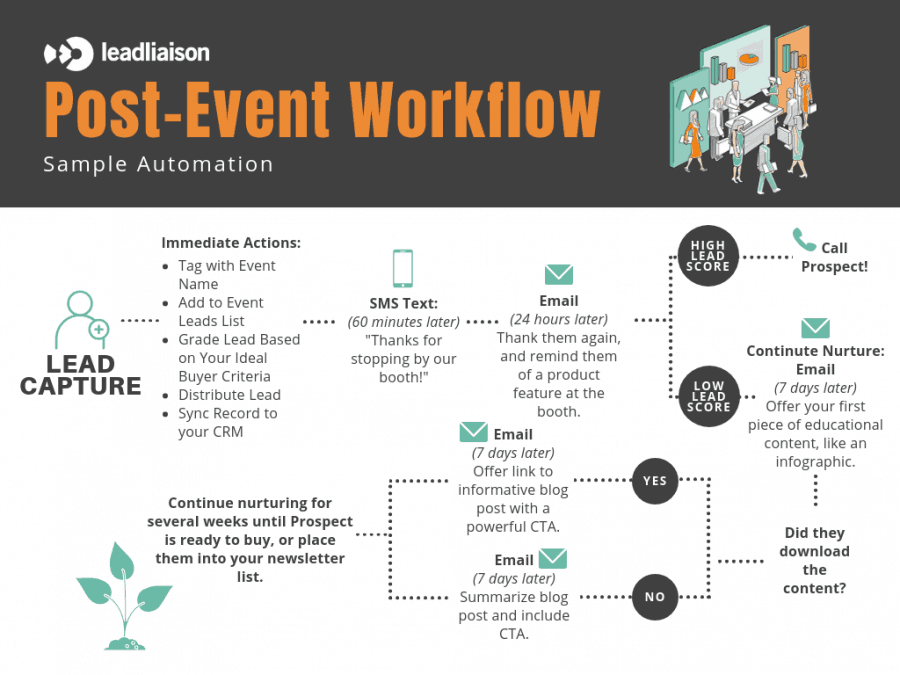Infographic: Post-Event Lead Nurturing Strategy
Want the executive summary? Download the infographic here.
To access our Event Lead Management Kit, which includes this resource, click here.
Marketing events can be a very costly effort. There’s the booth rental, the booth design/display, travel and expenses for your employees working the booth. Service costs like electricity, cleaning, or wifi can sneak up on you. Badge scanners are expensive (have you looked into other options?).
I think you get my drift: marketing events cost a lot of money. Return on investment (ROI) is paramount. Once your team has captured hot leads at an event, you should be prepared to follow up with those leads quickly and effectively. There’s no time to waste – don’t let your competitors beat you to the punch.
We are often asked for examples of how a business can (and should) nurture leads post-event. Below is an infographic that examines a tried-and-true post-event lead nurturing strategy.
Technology to Support Lead Nurturing Strategy
The first step in determining your post-event lead nurturing strategy is to make sure you have the technology in place to automate it. Don’t count on these things being done manually – it’s just not realistic. Companies are busier than ever these days, usually with multiple people wearing multiple hats – stretched thin. There’s also tons of room for distraction at (and after) marketing events. The more administrative tasks you can automate, the better. Let your employees spend their time building relationships and making connections.
There are lots of options out there, but we recommend a wholistic approach. Look for technology that works together, so you don’t have to spend time exporting and importing. For example, our event lead management solution allows businesses to create and customize lead capture forms, prepare intelligent post-event workflows, quickly capture leads onsite, instantly sync with a CRM, and then place them into those previously mentioned workflows. No additional technology is needed.
Of course, we love our solutions. But, there are lots of options out there! Just make sure you have something in place to be able to effectively execute your plan.
Lead Management Strategy – Instant Tasks
Create a list of all the actions you want to take once you’ve captured the lead’s information, and separate them into groups based on the time of the outreach. Here are a few examples of what you might want to do instantly:
- Tag the Prospect with the Event Name
- Add the Prospect to the Event Leads list
- Assign a grade or score to the Prospect based on your ideal buyer criteria
- Distribute the lead (Prospect) – based on round-robin, geography, or product interest
- Sync the Prospect Record with your CRM
Side Note – Lead Scoring vs. Lead Grading
Let’s talk more about lead score versus lead grade. You may want your reps to call a Prospect if their score is high and their grade is high. Or maybe just one or the other. To make that determiniation, you should know the differences.
Lead scoring is a way to measure engagement, and it happens over time. Even before your event, a Prospect may have already been to your website, scanning a few of your webpages, which would increase their score. It will continue to increase as they continue to interact with your website or your content.
On the other hand, grading is a way to measure how well a Prospect matches your ideal buyer criteria. Your reps can qualify and assign a grade onsite at the event. With our event lead management solution, reps can collect lead data quickly and either grade them in the moment, or they can go back later and grade them when they have a lull in booth traffic.
Lead Management Strategy – Starting Your Nuture
Once those organizational actions have been completed (usually within seconds), what do you want to do next? Let me answer that for you…you want to follow up. Insidesales.com conducted a study that found 35-50% of sales go to the vendor that responds first. That means that the timing of your follow up matters.
If at all possible, reach out to your leads within an hour of them visiting your booth. A great example of this kind of outreach is with a text message. If you’re capturing a lead’s mobile phone number, use your marketing automation platform to send a text message saying, “Hi Jane, it’s Bob. Thanks for stopping by our booth! We’ll be in touch soon – but in the meantime, here’s my number if you have any questions…” That is sure to make your company stand out.
24 Hours Later
Send an email. Even though you already sent a text message, send an email 24 hours later. Give your Prospect time to filter through messages from other booths, but not enough time that they forget who you are. Remind them of a product feature that sets you apart from other exhibitors at the trade show.
Pivot
At this point in the game, you may want to consider customizing your lead nurturing strategy based on the previously mentioned lead score and/or grade (depending on what matter most to your business) and how the Prospect interacts with your outreach or content. Your marketing automation platform should have the capability of customizing the workflow using this kind of criteria. If the lead score is high, assign a task to a rep to make a call. If it’s low, continue to nurture via email.
Don’t disqualify leads with a lower score or grade. They may be hesitant because they are taking this decision more seriously. Offer a piece of educational content, like an infographic or a case study. Try to be their source of education in the industry, so they begin to see your company as a thought leader.
If they download the content, you may want to pivot further based on that. If they downloaded it, offer another link to an informative blog post with a powerful call-to-action (CTA). Make the decision to reach out to you easy.
If they didn’t download the content, perhaps they need the same information as the lead above, but rather they need it summarized within the email itself to reduce effort. Include your CTA within the email itself, to make it even easier.
In Summary
Continue nurturing your Prospects for several weeks until they are ready to buy, or place them into your newsletter list so that you can continue your educational content without being too pushy.
It’s all about creating a sense of authority and innovation within your industry. Those that actively attend trade shows, conferences, or other marketing events are not passive. They are engaged, and their presence at an event will make them hyper-aware of you and your competitors.
If you decide to exhibit at an event, be prepared to make it count. Here’s an infographic that you can save for when the time comes. And, good luck!






